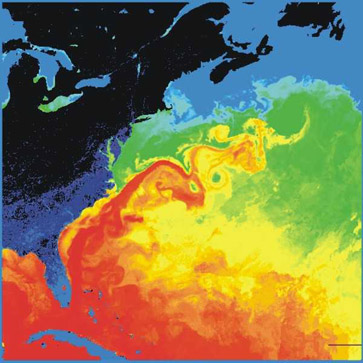A few years ago, I [wrote about][1] a minor long-term effect of the Chernobyl radiation leak. It took almost twenty years for a specific type of radioactive isotope to make landfall and destroy Norway’s reindeer-meat exports. Obviously, with all the other lives and ecologies and industries that Chernobyl affected, the small market in reindeer meat isn’t a big deal, but it reminds me that disasters can have far reaching consequences that no scientific model can ever compute. It’s the [long-tail effect][2] applied to catastrophes.
[ ][4]
][4]
I think about this when I read about the BP pipe rupture. The above image is of the [Gulf Stream][4], specifically showing the heat transfer from the Gulf of Mexico to the rest of the North Atlantic. How long, I wonder, will it take for the [suspended oil droplets][3] to surface and where will it happen? I fear that my friends in the Tampa area of Florida are going to experience a depressed environment for years to come.
But look at that map again. Imagine in 20 years what is left of east coast fisheries. Imagine how the oil and dispersants will affect cod hatcheries in Iceland and England. Imagine what effects oil and chemicals added in the millions of gallons into dozens of unique and crucial ecosystems will have on all of us. Can you? I know I can’t. I would never have expected an isolated nuclear disaster to have affected something thousands of miles away and dozens of years later. We make a mistake in thinking that radioactive isotopes are more dangerous or last longer than crude oil and chemical dispersants. The major difference is that it will take longer for the BP oil disaster to affect more people, but affect us it will. It’s only a matter of when. The long-tail of this catastrophe will be measured in decades.
[1]: http://macphoenix.com/index.php/2006/11/chernobyls-effect-on-norway/
[2]: http://en.wikipedia.org/wiki/Long_Tail
[3]: http://green.blogs.nytimes.com/2010/05/22/expert-head-scratching-on-the-plumes
[4]: http://en.wikipedia.org/wiki/Gulf_Stream
